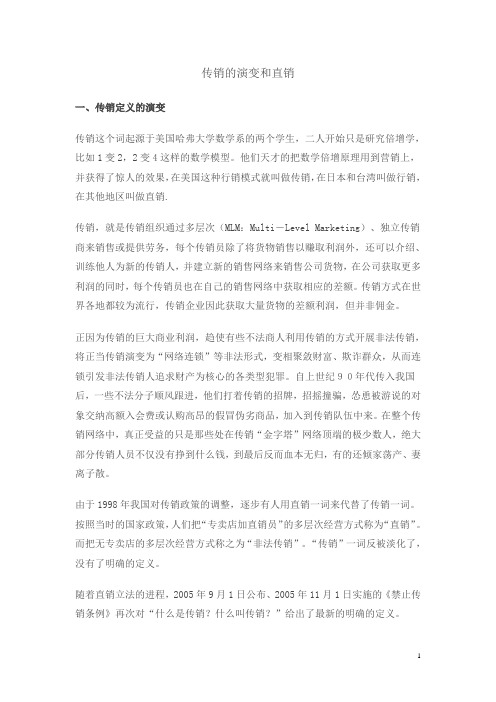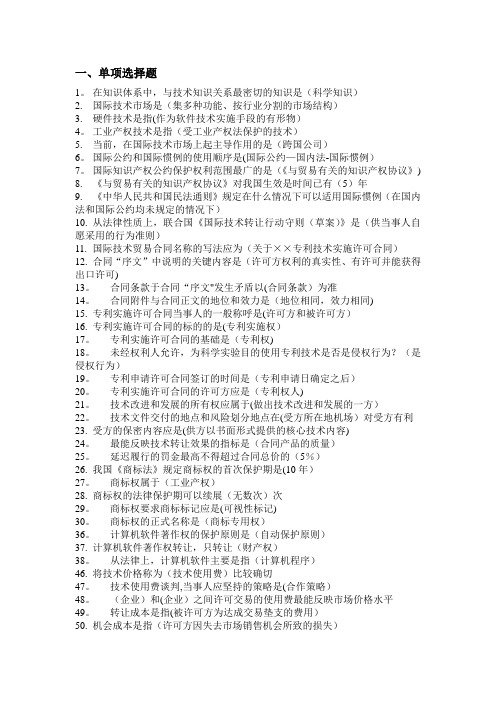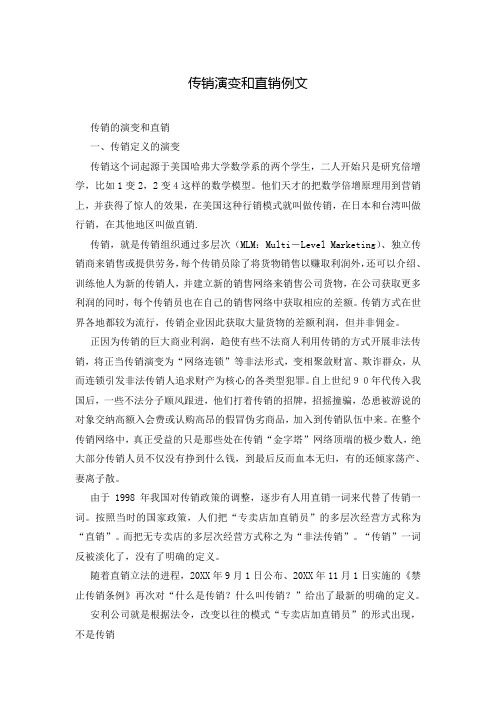入门费解释翻译
大学生安全知识答案(1-4)

大学生安全知识答案(1-4)《大学生安全知识》测试卷参考答案(一)一、不定项选择题(每题2分,共20分)1、B2、A3、D4、ABCDEF5、ABCDEFG6、AB7、ABC8、A9、ABCDEF10、ABCDEF二、填空题(每空1分,共30分)1、初期2、绝密机密秘密3、有警必接有难必帮有险必救有求必应联运服务4、人员保障物质保障制度保障5、有警必接有难必帮有险必救有求必应6、集会游行静坐要求抗议支持声援7、切忌显阔入乡随俗熟悉环境警惕慎行寻求帮助8、警察学校学生会中国驻该国大使馆三、名词解释(每题3分,共15分)1、心理调适:就是按照心理健康的标准,针对自己的心理形态,特别是存在心理(精神)障碍的人,积极进行调节和矫正,使自己始终保持健康的心理。
2、自律警示:是从反面列举个别同学因不能自律而危害社会,侵害他人权益,违法犯罪,最终受到处理的案例,以警示其他同学。
3、所谓高校“110”,是指学校保卫工作为实现快速反应,制止违法犯罪,加强防控工作,开展应急救助,为师生员工提供特别服务的防控、报警、服务工作体系及设立的特别服务电话。
4、紧急避险:是指为了使国家、公共利益、本人或者他人的人身、财产和其他权利免受正在发生的危险,不得已采取的行为。
经常锻炼身体,以增强免疫力。
㈡1、购买脏物是一种违法犯罪行为。
刑法第三百一十二条规定:“明知是犯罪所得的赃物而予以窝藏、转移、收购或者代为销售的,处3年以下有期徒刑、拘役或者管制,并处或者单处罚金”。
2、购买赃物,无论是有意还是无意,在客观上都是替不法分子销赃,也助长了其继续犯罪危害社会。
3、购买赃物,一旦发现就要受到刑事处罚,所购赃物全部没收,不但法律上受到处罚,经济上也将受到损失。
㈢1、对拟购的物品认真核查相关情况并索要发票。
一是要弄清物品的来历。
如查对发票、生产许可证、厂家证明等。
二是购买转卖物品,要弄清转卖人或者介绍人的身份(查看身份证等)。
三是购买自行车一类的交通工具,要核对购车发票或车牌、执照和钢印是否相符等。
传销的演变和直销

传销的演变和直销一、传销定义的演变传销这个词起源于美国哈弗大学数学系的两个学生,二人开始只是研究倍增学,比如1变2,2变4这样的数学模型。
他们天才的把数学倍增原理用到营销上,并获得了惊人的效果,在美国这种行销模式就叫做传销,在日本和台湾叫做行销,在其他地区叫做直销.传销,就是传销组织通过多层次(MLM:Multi-Level Marketing)、独立传销商来销售或提供劳务,每个传销员除了将货物销售以赚取利润外,还可以介绍、训练他人为新的传销人,并建立新的销售网络来销售公司货物,在公司获取更多利润的同时,每个传销员也在自己的销售网络中获取相应的差额。
传销方式在世界各地都较为流行,传销企业因此获取大量货物的差额利润,但并非佣金。
正因为传销的巨大商业利润,趋使有些不法商人利用传销的方式开展非法传销,将正当传销演变为“网络连锁”等非法形式,变相聚敛财富、欺诈群众,从而连锁引发非法传销人追求财产为核心的各类型犯罪。
自上世纪90年代传入我国后,一些不法分子顺风跟进,他们打着传销的招牌,招摇撞骗,怂恿被游说的对象交纳高额入会费或认购高昂的假冒伪劣商品,加入到传销队伍中来。
在整个传销网络中,真正受益的只是那些处在传销“金字塔”网络顶端的极少数人,绝大部分传销人员不仅没有挣到什么钱,到最后反而血本无归,有的还倾家荡产、妻离子散。
由于1998年我国对传销政策的调整,逐步有人用直销一词来代替了传销一词。
按照当时的国家政策,人们把“专卖店加直销员”的多层次经营方式称为“直销”。
而把无专卖店的多层次经营方式称之为“非法传销”。
“传销”一词反被淡化了,没有了明确的定义。
随着直销立法的进程,2005年9月1日公布、2005年11月1日实施的《禁止传销条例》再次对“什么是传销?什么叫传销?”给出了最新的明确的定义。
安利公司就是根据法令,改变以往的模式“专卖店加直销员”的形式出现,不是传销据第444号国务院令,公布的《禁止传销条例》中定义了什么是传销:传销是指组织者或者经营者发展人员,通过对被发展人员以其直接或者间接发展的人员数量或者销售业绩为依据计算和给付报酬,或者要求被发展人员以交纳一定费用为条件取得加入资格等方式牟取非法利益,扰乱经济秩序,影响社会稳定的行为。
国际技术贸易答案(第四版)

1。
在知识体系中,与技术知识关系最密切的知识是(科学知识)2. 国际技术市场是(集多种功能、按行业分割的市场结构)3. 硬件技术是指(作为软件技术实施手段的有形物)4。
工业产权技术是指(受工业产权法保护的技术)5. 当前,在国际技术市场上起主导作用的是(跨国公司)6。
国际公约和国际惯例的使用顺序是(国际公约—国内法-国际惯例)7。
国际知识产权公约保护权利范围最广的是(《与贸易有关的知识产权协议》)8. 《与贸易有关的知识产权协议》对我国生效是时间已有(5)年9. 《中华人民共和国民法通则》规定在什么情况下可以适用国际惯例(在国内法和国际公约均未规定的情况下)10. 从法律性质上,联合国《国际技术转让行动守则(草案)》是(供当事人自愿采用的行为准则)11. 国际技术贸易合同名称的写法应为(关于××专利技术实施许可合同)12. 合同“序文”中说明的关键内容是(许可方权利的真实性、有许可并能获得出口许可)13。
合同条款于合同“序文"发生矛盾以(合同条款)为准14。
合同附件与合同正文的地位和效力是(地位相同,效力相同)15. 专利实施许可合同当事人的一般称呼是(许可方和被许可方)16. 专利实施许可合同的标的的是(专利实施权)17。
专利实施许可合同的基础是(专利权)18。
未经权利人允许,为科学实验目的使用专利技术是否是侵权行为?(是侵权行为)19。
专利申请许可合同签订的时间是(专利申请日确定之后)20。
专利实施许可合同的许可方应是(专利权人)21。
技术改进和发展的所有权应属于(做出技术改进和发展的一方)22。
技术文件交付的地点和风险划分地点在(受方所在地机场)对受方有利23. 受方的保密内容应是(供方以书面形式提供的核心技术内容)24。
最能反映技术转让效果的指标是(合同产品的质量)25。
延迟履行的罚金最高不得超过合同总价的(5%)26. 我国《商标法》规定商标权的首次保护期是(10年)27。
实用财会英语-费用用语大全【会计实务经验之谈】

实用财会英语:费用用语大全【会计实务经验之谈】本文介绍了实用财会英语,有关于各类费用的会计术语.希望能帮到大家.费用用语:制造费用 Manufacturing overhead材料费 Materials管理人员工资 Executive Salaries奖金 Wages退职金 Retirement allowance补贴 Bonus外保劳务费 Outsourcing fee福利费 Employee benefits/welfare会议费 Coferemce加班餐费 Special duties市内交通费 Business traveling通讯费 Correspondence电话费 Correspondence水电取暖费 Water and Steam税费 Taxes and dues租赁费 Rent管理费 Maintenance车辆维护费 Vehicles maintenance油料费 Vehicles maintenance培训费 Education and training接待费 Entertainment图书、印刷费 Books and printing运费 Transpotation保险费 Insurance premium支付手续费 Commission杂费 Sundry charges折旧费 Depreciation expense机物料消耗 Article of consumption劳动保护费 Labor protection fees总监Director总会计师 Finance Controller高级 Senior 如高级经理为Senior Manager营业费用 Operating expenses代销手续费 Consignment commission charge运杂费 Transpotation保险费 Insurance premium展览费 Exhibition fees广告费 Advertising fees管理费用 Adminisstrative expenses职工工资 Staff Salaries修理费 Repair charge低值易耗摊销 Article of consumption办公费 Office allowance差旅费 Travelling expense工会经费 Labour union expenditure研究与开发费 Research and development expense 福利费 Employee benefits/welfare职工教育经费 Personnel education待业保险费 Unemployment insurance劳动保险费 Labour insurance医疗保险费 Medical insurance会议费 Coferemce聘请中介机构费 Intermediary organs咨询费 Consult fees诉讼费 Legal cost业务招待费 Business entertainment技术转让费 Technology transfer fees矿产资源补偿费 Mineral resources compensation fees排污费 Pollution discharge fees房产税 Housing property tax车船使用税 Vehicle and vessel usage license plate tax(VVULPT)土地使用税 Tenure tax印花税 Stamp tax财务费用 Finance charge利息支出 Interest exchange汇兑损失 Foreign exchange loss各项手续费 Charge for trouble各项专门借款费用 Special-borrowing cost小编寄语:不要指望一张证书就能使你走向人生巅峰。
传销演变和直销例文

传销演变和直销例文传销的演变和直销一、传销定义的演变传销这个词起源于美国哈弗大学数学系的两个学生,二人开始只是研究倍增学,比如1变2,2变4这样的数学模型。
他们天才的把数学倍增原理用到营销上,并获得了惊人的效果,在美国这种行销模式就叫做传销,在日本和台湾叫做行销,在其他地区叫做直销.传销,就是传销组织通过多层次(MLM:Multi-Level Marketing)、独立传销商来销售或提供劳务,每个传销员除了将货物销售以赚取利润外,还可以介绍、训练他人为新的传销人,并建立新的销售网络来销售公司货物,在公司获取更多利润的同时,每个传销员也在自己的销售网络中获取相应的差额。
传销方式在世界各地都较为流行,传销企业因此获取大量货物的差额利润,但并非佣金。
正因为传销的巨大商业利润,趋使有些不法商人利用传销的方式开展非法传销,将正当传销演变为“网络连锁”等非法形式,变相聚敛财富、欺诈群众,从而连锁引发非法传销人追求财产为核心的各类型犯罪。
自上世纪90年代传入我国后,一些不法分子顺风跟进,他们打着传销的招牌,招摇撞骗,怂恿被游说的对象交纳高额入会费或认购高昂的假冒伪劣商品,加入到传销队伍中来。
在整个传销网络中,真正受益的只是那些处在传销“金字塔”网络顶端的极少数人,绝大部分传销人员不仅没有挣到什么钱,到最后反而血本无归,有的还倾家荡产、妻离子散。
由于1998年我国对传销政策的调整,逐步有人用直销一词来代替了传销一词。
按照当时的国家政策,人们把“专卖店加直销员”的多层次经营方式称为“直销”。
而把无专卖店的多层次经营方式称之为“非法传销”。
“传销”一词反被淡化了,没有了明确的定义。
随着直销立法的进程,20XX年9月1日公布、20XX年11月1日实施的《禁止传销条例》再次对“什么是传销?什么叫传销?”给出了最新的明确的定义。
安利公司就是根据法令,改变以往的模式“专卖店加直销员”的形式出现,不是传销据第444号国务院令,公布的《禁止传销条例》中定义了什么是传销:传销是指组织者或者经营者发展人员,通过对被发展人员以其直接或者间接发展的人员数量或者销售业绩为依据计算和给付报酬,或者要求被发展人员以交纳一定费用为条件取得加入资格等方式牟取非法利益,扰乱经济秩序,影响社会稳定的行为。
[语法]fee和fare都表示“费用”,有何区别?
![[语法]fee和fare都表示“费用”,有何区别?](https://img.taocdn.com/s3/m/ea71dd19cd1755270722192e453610661ed95afb.png)
[语法]fee和fare都表示“费用”,有何区别?fee 和 fare虽然都是“费用”,但它们的含意截然不同。
fee 通常是指专业服务或咨询所索取的费用,如lawyer’s fees (律师费)、doctor’s fees (医师费) 或 counseling fees (咨询费)。
请看下面的例句:1.School fees have risen by 10% this year. (今年学费已涨了10%)2.I have to pay the lawyer fees for helping handle this matter. (请律师帮忙处理这一事项,我须支付律师费用。
)3.What are the fees for a weekly cleaning service? (每周的打扫服务费是多少呢?)此外,会费、入场费、仲介费、代办费、课程或活动的报名费、银行等机构的手续费等费用也都是使用 fee。
至于fare,一般而言,它仅指交通工具的票价,如公车、船舶、计程车或火车的票价或车资。
所以,搭乘公车所支付的费用,英文叫做bus fare 而不是bus fee;飞机票价叫做 airfare。
请看下面的例句:1.What’s the bus fare from here to the concert hall? (从这里到音乐厅的公车票价是多少呢?)2.The taxi fares here are so high.(这里的火车票费用太高了)。
3.I don’t have enough money for the train fare home. (我的钱不够付回家的火车票)#artContent h1{font-size:16px;font-weight: 400;}#artContent p img{float:none !important;}#artContent table{width:100% !important;}。
开办费 会计英语

开办费会计英语
开办费,又称启动费用或初始费用,是指企业在成立或开展新业务时所产生的各项支出。
这些费用包括但不限于:办公设备购置、人员招聘培训、租赁场地、注册登记、广告宣传等。
在会计英语中,开办费对应的术语为"Start-up expenses" 或"Initial expenses"。
正确处理和记录开办费对于企业财务健康至关重要。
根据我国会计准则,开办费应在企业成立或新业务开展当年一次性计入当期损益。
这有助于反映企业真实的经营状况,为投资者和经营者提供准确的信息。
在会计分录中,开办费通常记入"管理费用" 或"营业费用" 科目。
开办费对企业运营产生的影响不容忽视。
一方面,合理的开支能为企业创造价值,提高竞争力。
另一方面,过高的开办费可能导致企业资金链断裂,影响正常运营。
因此,企业在开展新业务或成立之初,应充分评估各项开支,力求做到成本最低、效益最大化。
为了减少开办费,企业可以采取以下策略和建议:
1.精简组织架构,避免冗员;
2.选择合适的办公地点,降低租金成本;
3.购置二手设备,节省购置成本;
4.利用网络平台,降低广告宣传费用;
5.加强与合作伙伴的沟通,共享资源。
总之,了解和掌握会计英语中与开办费相关的术语和概念,对企业管理者、财务人员以及有兴趣了解会计知识的人士都具有实际意义。
正规的技术转让合同6篇

正规的技术转让合同6篇正规的技术转让合同 (1) 受让方(甲方)_______国________公司________地址:________电话:________ 法定代表人:________ 职务:________转让方(乙方)_______国________公司________地址:________电话:________ 法定代表人:________ 职务:________第一章合同内容第一条乙方同意向甲方提供制造____合同产品的书面及非书面专有技术。
用该项技术所生产的合同产品的品种、规格、技术性能等详见本合同附件一。
第二条乙方负责向甲方提供制造、使用和销售合同产品的专有技术和其他所有有关技术资料。
技术资料的内容及有关事项详见本合同附件二。
第三条乙方负责安排甲方技术人员在乙方工厂进行培训,乙方应采取有效措施使甲方人员掌握制造合同产品的技术,具体内容见本合同附件三。
第四条乙方派称职的技术人员赴甲方合同工厂进行技术服务。
具体要求详见本合同附件四。
第五条乙方同意在甲方需要时,以最优惠的价格向甲方提供合同产品的备件,届时双方另签协议。
第六条乙方有责任对本合同项目甲方需要的关键设备提供有关咨询。
第七条乙方应向甲方提供合同产品的样机、铸件和备件,具体内容详见本合同的附件五。
第八条甲方销售合同产品和使用乙方商标的规定,见本合同第八章。
第二章定义第九条合同产品,指本合同附件一中所列的全部产品。
第十条蓝图,指乙方制造合同产品目前所使用的总图、制造图样、材料规范及零件目录等的复制件。
第十一条技术资料,是指为生产合同产品所必须具有的乙方目前正用于生产合同产品的全部专有技术和其他有关设计图纸、技术文件等。
第十二条标准,指为制造合同产品向甲方提供的技术资料中,由乙方采用制定的标准。
第十三条入门费,指由于乙方根据本合同第一章第二条、三条、四条、六条、七条规定的内容以技术资料转让的形式向甲方提供合同产品的设计和制造技术,甲方向乙方支付的费用。
- 1、下载文档前请自行甄别文档内容的完整性,平台不提供额外的编辑、内容补充、找答案等附加服务。
- 2、"仅部分预览"的文档,不可在线预览部分如存在完整性等问题,可反馈申请退款(可完整预览的文档不适用该条件!)。
- 3、如文档侵犯您的权益,请联系客服反馈,我们会尽快为您处理(人工客服工作时间:9:00-18:30)。
入门费(额外小费,额外租金)
入门费的数额由双方自由确定。
其可被视为:
●》额外租金(最常见的情况):业主希望预防租金的上涨与当地实际租赁价格的上涨不
一致的情况,在这种情况下,续约时将入门费考虑计算在租金内。
●》或,对“由业主提供的,与租金无关的各种经济对等物,尤其是商业利益”的补偿金。
●》或,对房屋等产业市值贬低以及房客从中获得商业财产的补偿金,包括在其租约延续
的权利条款中。
业主(称为出租人)和房客(称为承租人)在租约中明确入门费的性质。
若未指明,则仲裁人寻求双方的共同意愿。
在此情况下,一般将入门费作为额外租金考虑。
刚果”案结果几成定局
(湘潭大学非洲法律与社会研究中心副主任)
(2011-10-05 09:14:25)
注:这篇短文是在香港终审法院就“刚果案”做出最终裁决前所写,几天后香港终审法院就做出最终裁决。
所以,该文就没有发表。
现贴出,希望对该案有兴趣的人,可简单了解该案的过程。
“刚果”案结果几成定局
朱伟东
2011年8月26日,全国人大常委会根据香港特区终审法院的提请,就美国FG公司诉刚果民主共和国案(以下简称“刚果案”)所涉香港《基本法》第13条第1款、第19条的内容作出解释。
这是全国人大常委会第四次就《基本法》作出解释,也是香港特区终审法院首次主动提请全国人大常委会就《基本法》作出解释。
香港特区终审法院在8月30日收到释法文本后,已转交案件各方当事人。
根据该案日程安排,香港特区终审法院将在今年11月25日对该案作出最终判决。
在作出最终判决时,香港特区终审法院必然会考虑全国人大常委会作出的解释,因此,该案的结果几成定局。
“刚果(金)案”的起因是,1980年代,刚果向前南斯拉夫的Energoinvest公司(现为波斯尼亚的一家公司)签订水电工程项目合同。
工程完成并验收后,刚果一直没有支付工程款项。
Energoinvest公司根据合同中的仲裁条款向国际商会仲裁院提请仲裁。
仲裁庭在2003年作出有利于Energoinvest公司的仲裁裁决。
根据裁决,刚果应向这家公司支付3700万美元及其利息。
2004年,Energoinvest公司将仲裁裁决低价转让给美国FG公司,FG公
司成为仲裁裁决债权人。
2008年FG公司获悉中国国有企业中铁股份有限公司及其三个子公司即中国中铁(香港)有限公司、中国中铁资源开发股份有限公司和中国中铁华钢矿业股份有限公司在刚果取得采矿权,并会支付一笔总额约为3.5亿美元的“入门费”,因此就到中铁的上市所在地香港提起执行该仲裁裁决的诉讼,要求香港高等法院下令冻结这笔款项。
此时,最初仲裁裁决所确定的款项及其利息已达1.04亿美元。
FG公司要求香港高等法院从3.5亿美元的“入门费”中截留1.04亿美元作为抵债。
一审争议的问题是,1997年9月1日及以后,香港普通法是否承认限制主权豁免原则,即一国政府行为不享有豁免权而其商业行为享有豁免权?如香港普通法承认限制豁免原则,本案中的相关行为的性质如何认定?如果豁免权是绝对的或有关行为都属于政府行为,刚果是否因接受仲裁而放弃了豁免权?香港高等法院审理后认为,中国公司支付刚果的采矿“入门费”并不是商业行为,该交易是两个主权国家之间的合作,中国在刚果的基础设施建设项目是为了发展该国经济,造福刚果人民。
对于第三个问题,法院认为,一国放弃诉讼豁免并非意味着同时放弃执行豁免,特别是刚果不是《纽约公约》的成员国,刚果接受仲裁不能意味着该国明确放弃执行豁免权。
香港高等法院在2008年12月作出判决,判定香港高等法院对该案没有管辖权,并撤销了禁止中铁公司向刚果支付入门费以及刚果不得收取入门费的禁令。
FG公司不服该判决,向香港高等法院上诉法庭提起上诉。
上诉法庭审理后在2010年2月10日作出判决,认为应该把国家豁免视为法律方面的事情,由法院所在地的法院进行裁决。
因此,香港高等法院对该案有管辖权。
此外,上诉法庭认为,香港回归后,香港普通法仍沿用限制性豁免原则,由于本案有关行为是商业行为,所以,刚果不享有豁免权。
这样,FG公司要求执行仲裁裁决的申请得到上诉法庭的准许。
刚果对此上诉判决不服,向香港终审法院提起上诉。
鉴于案件涉及国家主权和中央人民政府的外交权力,此案在香港高等法院原讼法庭、上诉法庭、终审法院审理过程中,外交部通过驻港特派员公署分别向香港特区政府政制及内地事务局发出三封函件,指出我国一贯坚持的国家豁免原则并统一适用于全国,包括香港特别行政区。
2011年6月8日,香港终审法院作出临时判决,裁定香港特区应遵循中央人民政府决定采取的国家豁免规则,刚果享有国家豁免,香港法院对刚果无司法管辖权。
鉴于该临时判决涉及对香港《基本法》关于中央人民政府管理的事务以及中央和香港特别行政区关系条款的解释,香港终审法院认为有责任按照香港《基本法》第158条第3款的规定,在作出终局判决前提请全国人大常委会解释相关条款,并在全国人大常委会作出解释后依据该解释作出最终判决。
2011年7月5日香港律政司司长将法院有关提请释法的函件以及相关文件交予国务院港澳事务办公室,以转呈全国人大常委会。
香港特区终审法院提请全国人大常委会解释的问题如下:(1)根据第13条第1款的真正解释,中央人民政府是否有权力决定中华人民共和国的国家豁免规则或政策;(2)如有此权力,
根据第13条第1款和第19条的真正解释,香港特区(包括香港特区的法院)是否:①有责任援用或实施中央人民政府根据第13条第1款所决定的国家豁免规则或政策;或②反之,可随意偏离该规则或政策,并采取一项不同的规则;(3)中央人民政府决定国家豁免规则或政策是否属于《基本法》第19条第3款第一句中所说的‘国防、外交等国家行为’;以及(4)香港特区成立后,香港原有(即1997年7月1日之前)的有关国家豁免的普通法是否须在适用时作出必要的变更、适应、限制或例外,以确保这方面的普通法符合中央人民政府所决定的国家豁免规则或政策。
对上述问题,全国人大常委会作出如下解释:国务院即中央人民政府行使管理国家对外事务的职权,国家豁免规则或政策属于国家对外事务中的外交事务范畴,中央人民政府有权决定中华人民共和国的国家豁免规则或政策,在中华人民共和国领域内统一实施。
根据香港《基本法》第13条第1款规定,管理与香港特区有关的外交事务属于中央人民政府的权力,中央人民政府有权决定在香港特区适用的国家豁免规则或政策。
决定国家豁免规则或政策是一种涉及外交的国家行为。
依照《基本法》第19条的规定,香港特区法院对中央人民政府决定国家豁免规则或政策的行为无管辖权。
因此,香港特区法院在审理案件时遇有外国国家及其财产管辖豁免和执行豁免问题,须适用和实施中央人民政府决定适用于香港特区的国家豁免规则或政策,不得偏离上述规则或政策,也不得采取与上述规则或政策不同的规则。
香港特区原有法律中有关国家豁免的规则,从1997年7月1日起,在适用时须作出必要的变更、适应、限制或例外,以符合中央人民政府决定采取的国家豁免规则或政策。
我国目前还没有有关国家豁免的专门立法,但从我国外交部在外国法院审理的涉及中国政府的案件所做的声明来看,我国坚持的是绝对豁免原则,即一国行为无论是政府行为还是商业行为均享有豁免权。
我国政府在2005年9月签署了《联合国国家及其财产管辖豁免公约》,该公约采用了限制豁免原则。
但由于全国人大常委会尚未批准该公约,该公约在我国还不具有法律效力。
全国人大常委会的上述解释进一步澄清了我国在国家豁免方面的立场。
根据该解释,刚果作为主权国家就其相关行为在我国享有豁免权,香港提起法院对该案没有管辖权。
因此,香港特区法院不得下令禁止中铁公司向刚果支付“入门费”,也不得下令禁止刚果收取这笔“入门费”。
(湘潭大学非洲法律与社会研究中心副主任)。
